Advertisements
Advertisements
प्रश्न
A small object is placed at the centre of the bottom of a cylindrical vessel of radius 3 cm and height 4 cm filled completely with water. Consider the ray leaving the vessel through a corner. Suppose this ray and the ray along the axis of the vessel are used to trace the image. Find the apparent depth of the image and the ratio of real depth to the apparent depth under the assumptions taken. Refractive index of water = 1.33.
उत्तर
Given,
Refractive index of water μ = 1.33
Radius of the cylindrical vessel = 3 cm
Height of the cylindrical vessel = 4 cm
Let x be the length of BD
According to the diagram,
\[\frac{x}{3} = cot r . . . . (i)\]
Using Snell's law,
\[\frac{\sin i}{\sin r} = \frac{1}{1 . 33} = \frac{3}{4}\]
\[ \Rightarrow \sin r = \frac{4}{3}\sin i = \frac{4}{3} \times \frac{3}{5} = \frac{4}{5}\]
\[As \sin i = \frac{BC}{AC} = \frac{3}{5}\]
\[ \Rightarrow \cot r = \frac{3}{4} . . . . . (ii)\]
From (i) and (ii),
\[\frac{x}{3} = \frac{3}{4}\]
\[ \Rightarrow x = \frac{9}{4} = 2 . 25 \text{ cm }\]
Hence, the ratio of real and apparent depth of the image will be \[4: 2 . 25 = 1 . 78\] 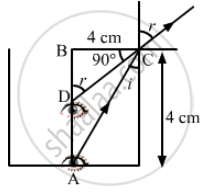
APPEARS IN
संबंधित प्रश्न
Use the mirror equation to show that an object placed between f and 2f of a concave mirror produces a real image beyond 2f.
Use the mirror equation to deduce that an object placed between the pole and focus of a concave mirror produces a virtual and enlarged image.
Using mirror formula, explain why does a convex mirror always produce a virtual image.
An object is kept on the principal axis of a concave mirror of focal length 10 cm. at a distance of 15
cm from its pole. The image formed by the mirror is:
(a) Virtual and magnified
(b) Virtual and diminished
(c) Real and magnified
(d) Real and diminished
A point object O is placed at a distance of 15cm from a convex lens L of focal length 1 Ocm as shown in Figure 5 below. On the other side of the lens, a convex mirror M is placed such that its distance from the lens is equal to the focal length of the lens. The final image formed by this combination is observed to coincide with the object O. Find the focal length of the convex mirror
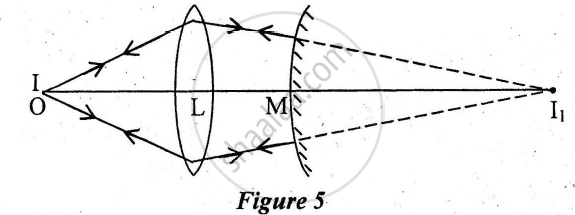
Use the mirror equation to show that an object placed between f and 2f of a concave mirror forms an image beyond 2f.
Can a plane mirror ever form a real image?
following Figure shows two rays A and B being reflected by a mirror and going as A' and B'. The mirror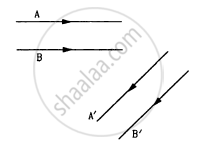
Mark the correct options.
A light ray is incident at an angle of 45° with the normal to a √2 cm thick plate (μ = 2.0). Find the shift in the path of the light as it emerges out from the plate.
A light ray is incident normally on the face AB of a right-angled prism ABC (μ = 1.50) as shown in figure. What is the largest angle ϕ for which the light ray is totally reflected at the surface AC?

Find the maximum angle of refraction when a light ray is refracted from glass (μ = 1.50) to air.
Write any one use for each of the following mirrors :
(a) Convex
(b) Concave
The figure below shows the positions of a point object O, two lenses, a plane mirror and the final image I which coincides with the object. The focal length of the convex lens is 20 cm. Calculate the focal length of the concave lens.
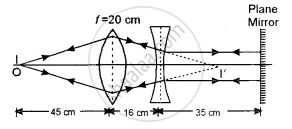
For paraxial rays, show that the focal length of a spherical mirror is one-half of its radius of curvature.
A parallel beam of light is allowed to fall on a transparent spherical globe of diameter 30cm and refractive index 1.5. The distance from the centre of the globe at which the beam of light can converge is ______ mm.
Car B overtakes car A at a relative speed of 40 ms-1. How fast will the image of car B appear to move in the mirror of focal length 10 cm fitted in car A, when car B is 1.9 m away from car A?
When a clock is viewed in a mirror, the needles exhibit a time which appears to be 8:20. Then the actual time will be:
Two plane mirrors are inclined at an angle of 40°. The possible number of images of an object placed at point P would be?
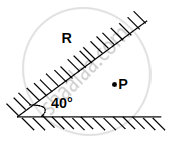
A point object is placed at a distance of 30 cm from a convex mirror of a focal length of 30 cm. What is the separation between the image and the object?
